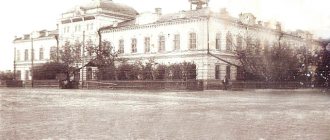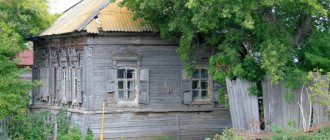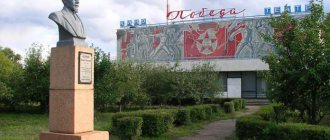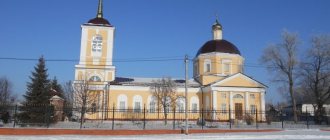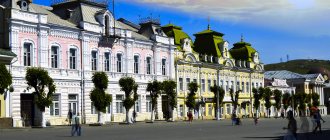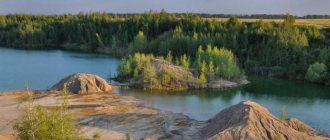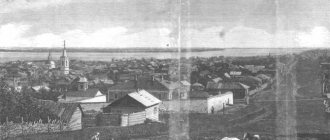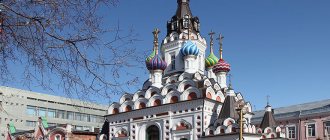About the city of Pugachev
Historians consider 1764 to be the official founding date of the village. The Old Believers, called by the manifesto of Empress Catherine II, arrived here and founded their own settlement, which was called Mechetnaya.
In 1765, the settlement consisted of a single street on which “264 male souls” lived.
Immediately after this date, the fate of the settlement turned out to be closely connected with the fate of Emelyan Pugachev.
The Old Believer monastery at that time was headed by Abbot Philaret. It was from him that the future leader of the uprising in 1772, who found himself in the settlement, learned about the unrest among the Yaik Cossacks.
This information became the basis for his decision to impersonate Emperor Peter III.
After this bright point in the history of the place, it did not show itself in any way, but in the first half of the 19th century its population began to grow sharply. As the population grew, so did spirituality.
For some time Mechetnaya was the regional center of Russian Old Believers, but this was discontinued in the late 1820s when a significant portion of the area's Old Believers were "brought to the common faith" by military bayonets by Samara Governor Golitsyn .
The activity of the townspeople led to the fact that in 1835, Emperor Nicholas I ordered that the village be considered a city.
It was given the name Nikolaevsk. This was marked by a festive ceremony, which took place on May 9, 1836.
It is interesting that this is how the new county town began to head the area in which the rich trading settlement of Balakovo and the main German colony on the Volga were located - Ekaterinenstadt, in which, at the invitation of Catherine the Second, Protestants arriving from Germany and Denmark settled; now it is called Marx.
The city developed quite quickly in such conditions; there were men's and women's gymnasiums, schools, and parish schools.
In November 2022, Soviet power was established in the city; it did not last long; Nikolaevsk was captured by Czechoslovak invaders.
It was fought off by the legendary army commander V.I. Chapaev, who was elected military commissar of the Nikolaev district, and at his suggestion the liberated settlement began to be called Pugachev, but not in honor of the Cossack, but in honor of the Pugachev brigade. Since 1928 it has been a regional center.
During the Soviet period, a flour mill, a bakery, a dairy plant, a plant for the extraction and processing of non-metallic building materials, and a crushing and screening plant were built here.
The population works either here or at agricultural enterprises, of which there are many in the area. Significant events of recent years include the opening in 2022, by decision of Governor V. Radaev, of the first solar power plant in the region.
Emelyan Pugachev became “Emperor Peter III” here
In 1772, the fugitive Cossack Emelyan Pugachev . A brave warrior, a participant in the Seven Years and Russian-Turkish Wars, Pugachev lost interest in military service after a serious illness. Having failed to achieve resignation, Pugachev went to his sister for treatment in Taganrog, where he helped his son-in-law and several of his comrades escape from service. When the authorities became aware of Pugachev’s involvement, he himself had to flee.
Article on the topic
Romanov Dynasty: Great Empire on Great Blood
Pugachev communicated closely with the Old Believers, who suggested him a way to legalize himself: go to Poland, get a passport there as an Old Believers, returning to his homeland by order of the Empress. It was in this status that the Cossack arrived in Mechetnaya Sloboda.
Having learned from the rector of the Old Believer monastery of the Presentation of the Virgin Mary Philaret about the unrest of the Cossacks in the Yaitsky town, Pugachev decided to impersonate the “miraculously saved Emperor Peter Fedorovich.”
Unlike his predecessor False Dmitry , Pugachev in no way resembled the tsar, had no education, and his legend looked simply ridiculous. Nevertheless, for the masses, outraged by the policies of Catherine the Second, the “emperor from Mechetnaya Sloboda” turned out to be a completely suitable leader.
Coat of arms of the city of Pugachev
The city's coat of arms was adopted in 1998; it completely repeats the historical one, previously approved in 1910.
Its description indicates that in the silver field of the shield there are two green sheaves of wheat, placed crosswise and tied with a scarlet ribbon.
In the free part there is the coat of arms of the Saratov region.” The coat of arms symbolizes that the main wealth of the region is its fertile fields.
Population of Pugachev, Saratov region
Now the city is home to just over 40 thousand people. This is 374th place out of 1113 cities in Russia. There are only 58 thousand in the area.
The national composition is diverse, 85% are Russian, 5% are Tatars. There are two Bashkir settlements, Maksyutovo and Bobrovy Gai.
Kazakhs and Armenians also live in the area. In total, the district includes 9 municipalities and 64 settlements.
The economy is based on agricultural production, but there are also industrial facilities.
Among them is the largest crushed stone quarry in the region, which is located near the village of Zavolzhskaya. There is a brick factory and a reinforced concrete plant that provide materials to the construction industry.
A small solar power plant, created in 2022, should be transformed into a powerful energy supply enterprise with a capacity of 15 MW by 2040.
Wonderful people of Pugachev
Many wonderful people were born and raised in Pugachevsk. The most famous native of the area, without a doubt, is the famous Soviet writer, Count Alexei Nikolaevich Tolstoy .
The author of The Golden Key was first published on January 10, 1883. The writer, who created many historical and science fiction novels, became a laureate of three Stalin Prizes.
Also, Vladislav Pakhomovich Serikov, a famous builder, brought glory to the city. Asyat Mansurovich Saitov, a famous road cyclist, was also born here.
During the Second World War, 29,039 people went to the front from the Pugachevsky district; they fought on all fronts and in partisan detachments.
8336 Pugachevites did not return. Many of them were awarded orders and medals, 17 became heroes of the Soviet Union, and Pugachevites I.N. Soloviev, V.A. Kuznetsov and A.I. Kolmykov - full holders of the Order of Glory.
The author of “The Golden Key” was born in Pugachev
On January 10, 1883, one of the most famous townspeople, writer Alexei Tolstoy, . The famous “red count”, the author of fantasy and historical novels such as “Aelita”, “Peter the Great”, “Walking in Torment”, has been known to most Russians since childhood as the creator of “The Adventures of Pinocchio” - an artistic retelling in a new way of the fairy tale of the Italian Carlo Collodi "The Adventures of Pinocchio. The history of a wooden doll." Tolstoy began this book while still in exile, and completed it upon his return to the Soviet Union.
Article on the topic
Count Alyoshka. Contemporaries believed that Tolstoy had sold out to power
Tolstoy himself wrote about the fairy tale like this: “I’m working on Pinocchio. At first I only wanted to write the contents of Collodi in Russian. But then I gave up on it, it turns out a bit boring and bland. With Marshak’s , I am writing on the same topic in my own way.”
The version of a native of Nikolaevsk was published in the USSR 182 times, the total circulation exceeded 14.5 million, the book was translated into 47 languages of the world.
In 1936, Tolstoy wrote a play based on his own fairy tale, which became the basis not only for numerous theatrical productions, but also for films.
Tolstoy wrote about the life of his native Nikolaevsk in two of his novels - “The Lame Master” and “Cranks”.
Education and culture of Pugachev
Citizens learn about events taking place in the region from the publication “New Zavolzhye”, which also has an online version. There are also 2 more newspapers published in the city - “Pugachev Time” and “Provincial Life”.
The memorial museum of Vasily Ivanovich Chapaev and the local history museum named after Konstantin Ivanovich Zhuravlev are required to visit. This Soviet scientist, geologist, paleontologist, and archaeologist led the museum for a long time and put great effort into the formation of its collections. He was born in the village of Varvarovka, Pugachevsky district.
Pugachev's educational institutions satisfy the needs of both the city and the region. There are secondary schools here, there are already 7 of them, and the agricultural technical school trains personnel for the most developed sector of the economy in the region.
You can get a vocational education at the Polytechnic Lyceum. Higher education is available at the Pugachev branch of the Saratov State Agrarian University. There is an art school in the city for gifted children.
There are 4 houses of culture where famous performers perform tours, and 7 libraries.
The modern name of the city was given by Chapaev
Soviet power was established in Nikolaevsk on November 27, 1917. Another people's rebel was directly related to these events - Vasily Chapaev . Having joined the Bolshevik Party in September 1917, Chapaev was elected commander of the 138th Infantry Reserve Regiment, which was based in Nikolaevsk.
Article on the topic
The real Chapaev. The legendary division commander did not become a general, but his son became one
In December 1917, the local Congress of Soviets elected Chapaev military commissar of the Nikolaev district. The decisive Vasily Ivanovich formed 14 district detachments of the Red Guard on the territory entrusted to him. On the basis of these detachments, in May 1918, two regiments of the regular Red Army were formed: named after Stepan Razin and named after Emelyan Pugachev. These two regiments made up the Pugachev brigade, of which Chapaev became the brigade commander.
During the Civil War, the Pugachev brigade drove the White Guards out of Nikolaevsk. On November 11, 1918, on the initiative of Chapaev, whose fame and popularity by that time were extremely high, Nikolaevsk was renamed Pugachev in honor of the brigade that liberated it.
Streets and sights of Pugachev
Among the architectural attractions, old merchant mansions attract attention, one of which houses an art school. The city administration now operates in the former zemstvo building.
The building is an interesting example of urban public architecture from the second half of the nineteenth century.
You can appreciate the merchant style of the buildings of the former Nikolaevsk by examining the trading house of the Schmidt brothers, built in 1912.
You can also appreciate the interesting style of the men's gymnasium. The temple in the name of the Resurrection of Christ was erected in 1889.
There are several monuments in Pugachev. The traditional monument to V.I. Lenin stands on the main square. Monuments were erected to V.I. Chapaev and S.M. Kirov who visited the city.
The bust of Count A.N. Tolstoy will remind you of Pugachev’s connection with the famous writer. It will be interesting for many to look at the recently built monument to the Mi-24V helicopter.
The city is very well maintained; in 2013, work was carried out to replace all city lighting fixtures. There are parks, playgrounds, and places for walking. A well-maintained city park invites you to spend hours there with your children or alone. There is an old motor ship on the shore, adding regional and historical flavor to the park.
Neighborhoods of Pugachev
Nature lovers should definitely visit the Oryol Uvaly tract and the Tulip Steppe Landscape and Botanical Natural Monument.
There is good fishing on the banks of the Irgiz; here you can spend a long time for those who like to relax on the water. Old Believer monasteries existed on the high bank for a long time.
It is also possible to visit the former St. Nicholas Convent, founded in 1764 by Old Believers, converted into Orthodox in 1841. The temple in the name of St. Nicholas the Myra has been restored here, and on the bank of the Bolshoi Irgiz there is a font with a rotunda.
A visit to Pugachev will become an interesting page in the life of every person who is passionate about Russian history. The great Cossack rebel, Chapaev, and Kirov visited this city. Walking through the streets they walked along, you can feel the connection of times.
History paragraph
In 1762, Catherine II issued a manifesto, which stated that it was necessary to settle the left bank of the great river. From that moment on, schismatics, runaway peasants and freedom-loving and rebellious people began to populate this land.
Nearby, monasteries, women's, and men's monasteries were formed, which in the near future became famous. For a very long period of time they acted as dens for various people, who were hiding under the guise of adherents of the fatherly faith. Only in 1828, thanks to the efforts of the Saratov governor Golitsyn and military force, was it possible to convert some of the Old Believers to the new faith. Currently, this is a place where a huge number of people make pilgrimages who want to touch the holy relics and hear angelic chants.
